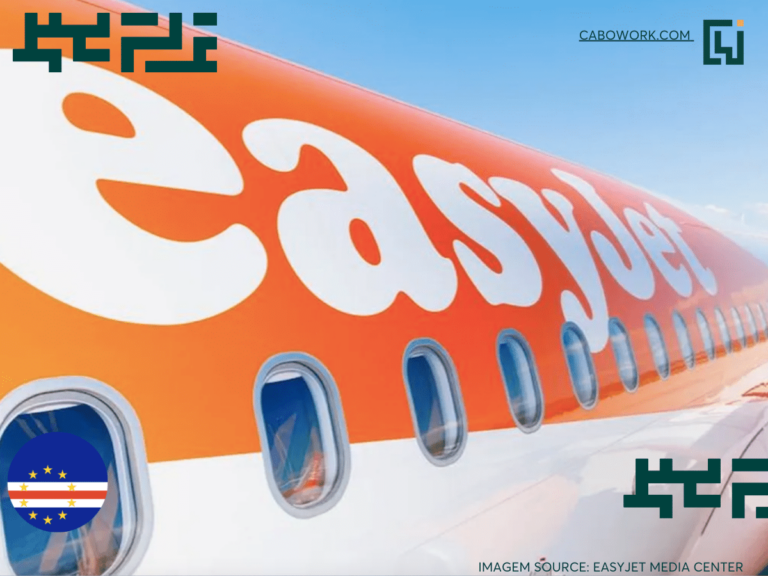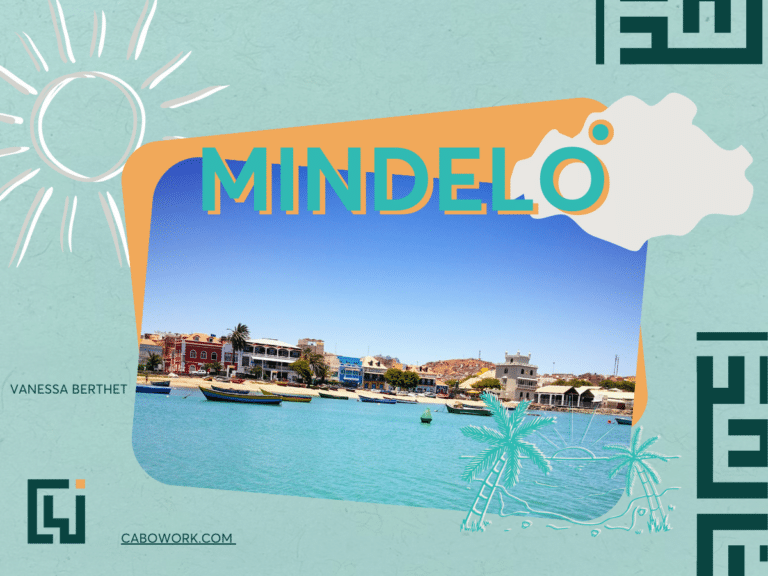Culture of Cape Verde: Key Highlights
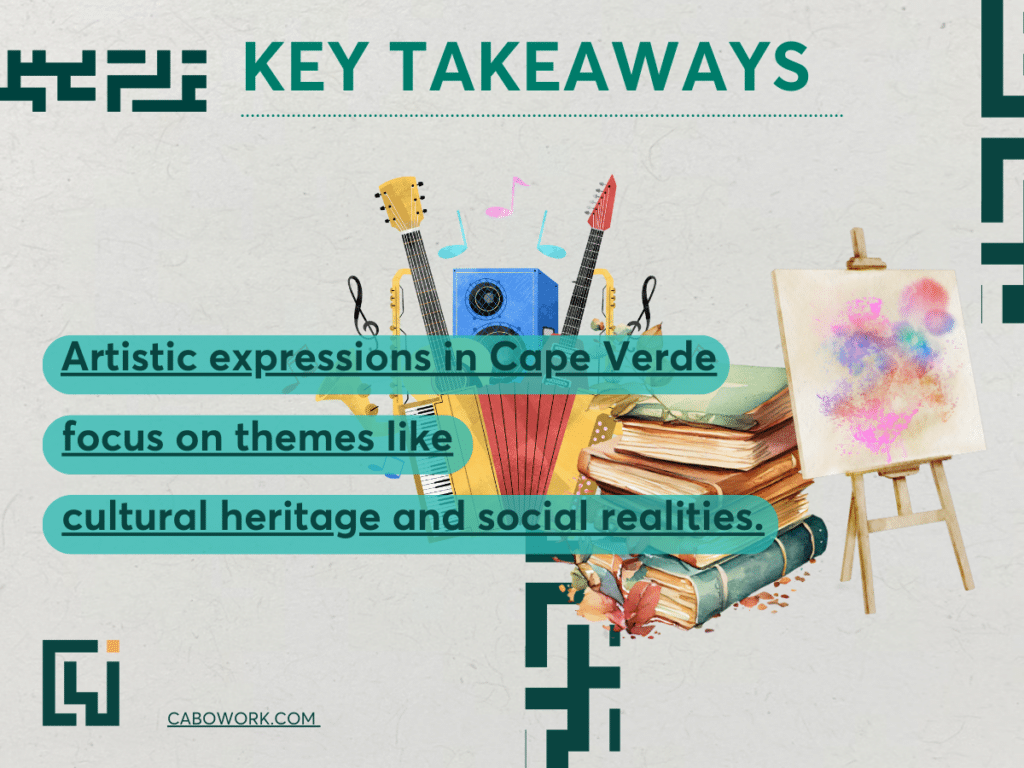
- Artistic Expressions: Music and dance are central to Cape Verdean culture. Musicians like Cesária Évora or Tito Paris are world-renowned artists.
- Literary Tradition: National literature explores themes of independence, migration, identity, and social realities.
- Cultural Blend: Cape Verdean culture is a fusion of African, Portuguese, and Brazilian influences, evident in its music, dance, art, literature, and cuisine.
The Resilience of Cape Verdeans

The Portuguese first settlers arrived in the archipelago in 1462. In the 18th century, many Cape Verdeans immigrated to America, but the steamships in the 19th century revitalized the islands, especially with the development of ports like Mindelo.
After 1975 and in the following decades, the government’s efforts have transformed Cape Verde into a thriving destination. Today, the archipelago takes pride in its rich heritage and maintains strong cultural ties with Portugal and the African mainland.
A Kaleidoscope of Culture
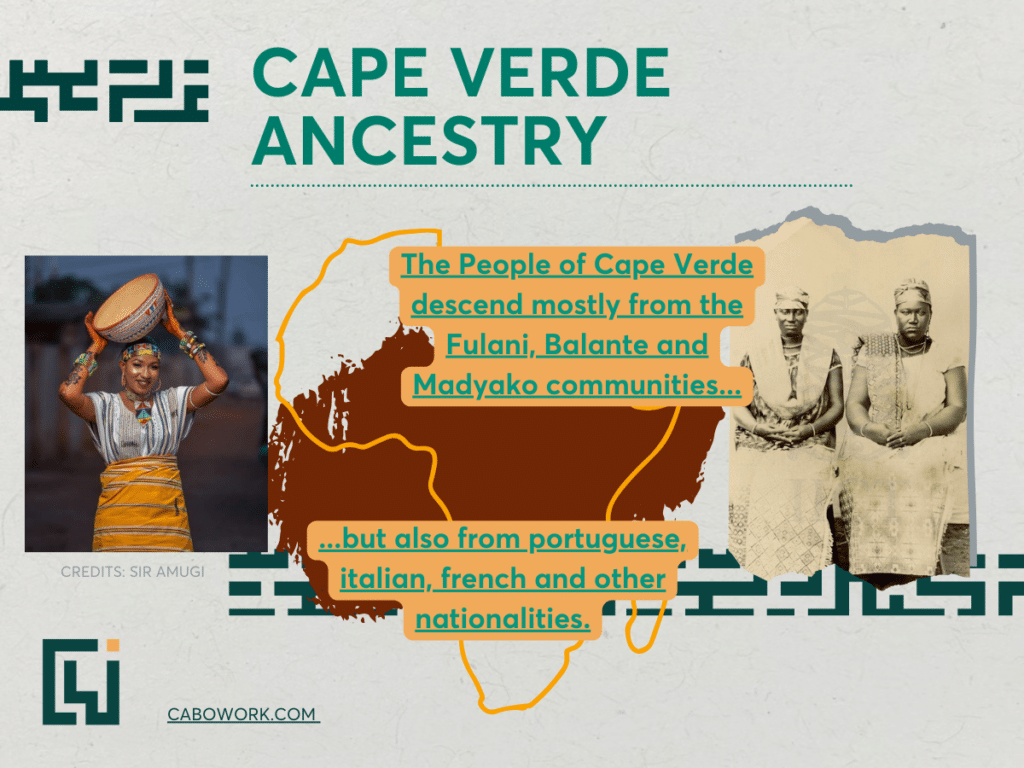
Cape Verde is home to several ethnic groups, including African communities such as the Fulani, Balante, and Mandyako (or Manjaco). A small population of European descent is mainly of Portuguese origin, with roots in the Algarve and Azores. There are also individuals of Italian, French, English, and Jewish ancestry settled on the islands.
Culture of Cape Verde: Social Projects and Artistic Expression
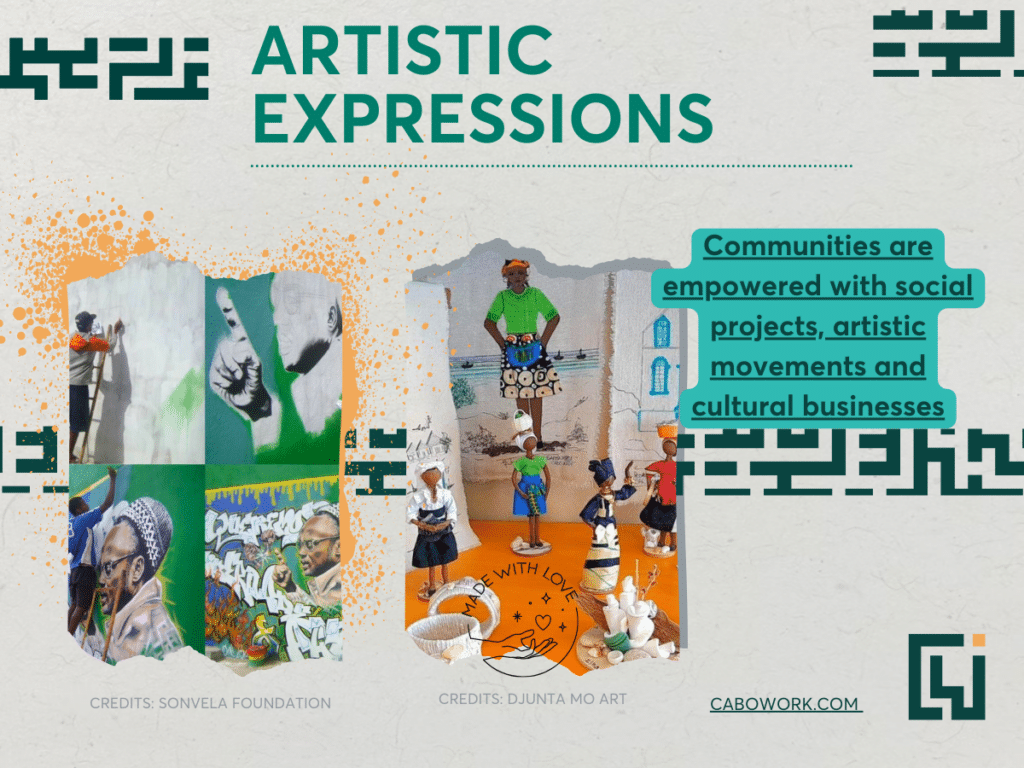
The Cabo Verde archipelago is divided into two groups: the Barlavento (Windward) group to the north and the Sotavento (Leeward) group to the south, and Cape Verdeans are scattered across nine islands.
Here you’ll discover a place where art empowers communities, history whispers through landscapes, and cultural pride shines brightly with examples of social projects, artists, and businesses that contribute to the culture of Cape Verde.
Sal Island:
- In Sal Island, Djunta Mo Art was created so they could help develop a sustainable market for Cape Verdean art, culture, and food products. They focus on supporting local artisans, especially women, cooperatives, and young people.
- Djunta Mo Art helps artisans throughout the production process from creation to final sale. This includes assisting with material acquisition, product enhancement, pricing guidance, and even marketing and sales. They also support the Nú Bai Association, a non-profit organization dedicated to improving educational opportunities in Cape Verde.
Santiago:
- Also, in Santiago, the 265 Creative Festival, held in Assomada, provides a platform for local artists, musicians, and designers to showcase their talents, enriching the island’s cultural scene.
While you’re in Santiago, do not miss the opportunity to know the work of Tutu Sousa.
His project, “Rua da Arte,” transformed his childhood home and surrounding streets into an open-air museum, celebrating artistic expression. - In the Achada Grande Frente neighbourhood of Praia, the Xalabas di Kumunidadi project employed the power of urban art to revitalize the community and empower its residents. The project encompassed a series of workshops conducted by international and national graffiti artists, including the Portuguese artist Vhils and others like Nemo, Paula Plim, and Finok.
These workshops provided local youth with the skills and tools to express themselves creatively, while simultaneously transforming the neighborhood’s physical landscape.
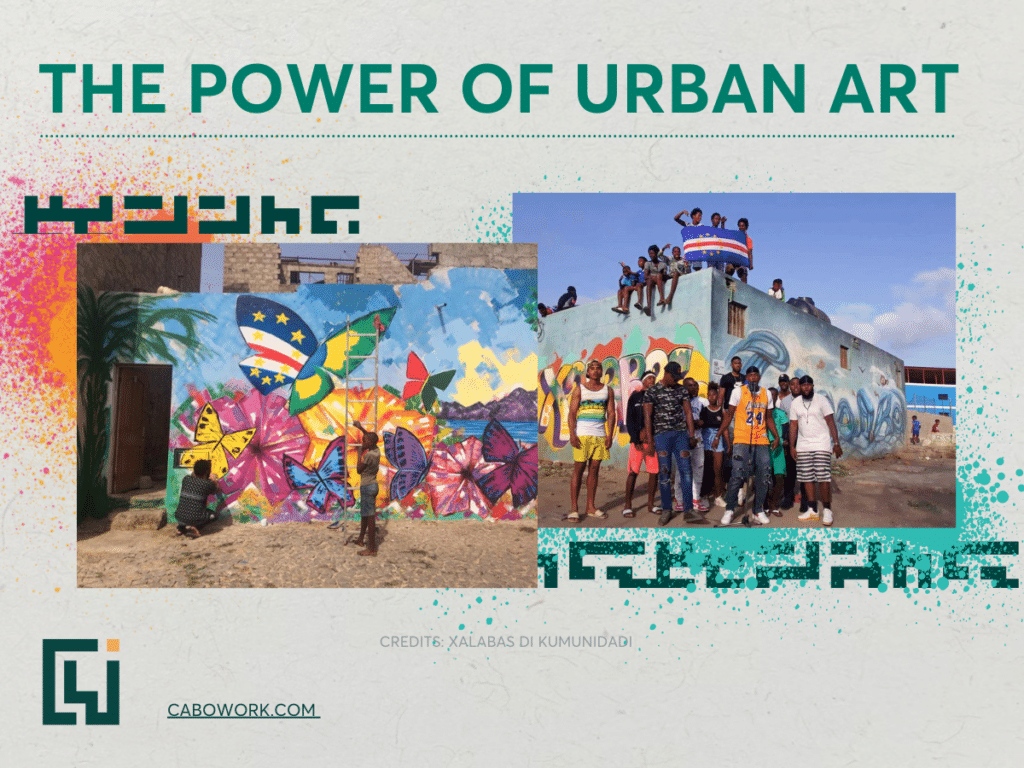
São Vicente:
The Island of São Vicente offers a fantastic blend of culture, history, and natural beauty. Mindelo is the cultural center of Cabo Verde, the heart of the island, and a must-visit for those wanting to experience Cape Verdean music and cultural life.
- Learn about Cape Verdean culture at the Centro Cultural do Mindelo or visit CNAD, the National Center for Arts, Crafts and Design.
- In Mindelo, the Sonvela Arte is a project created by the Sonvela Foundation. This project’s mission is to change the lives of people living in infamous neighbourhoods in the city of Mindelo.
By transforming the neighbourhood with painting and graffiti together with the residents, Sonvela Arte builds their self-esteem and creates opportunities on the job market and in tourism. Sonvela Arte believes in the power of art and culture, and that they can bring social change.
From environmental and cultural guardians to artistic expressions, the islands hums with creativity and social consciousness.
Are you planning on staying in Mindelo for a couple of days? Explore the colonial architecture of this city as well as its culinary delights. Take a look at the two-day itinerary that we’ve prepared for you!
Culture of Cape Verde, Music & Dance

Cape Verde’s artistic landscape is a vibrant tapestry woven from threads of African, European, and Brazilian influences. This fusion is particularly evident in the nation’s music and dance but also extends to its visual arts.
The soul of Cape Verde lies in its music, a rich tapestry of genres reflecting the country’s history.
Cape Verde Islands & Music
Music reigns supreme in Cape Verde, acting as a powerful expression of joy, sorrow, longing, and resilience. Although Portuguese is the official language, Crioulo is widely spoken in various dialects and Cape Verdean songwriters often compose in Crioulo. Different genres reflect the island’s cultural tapestry:
- Batuku (Batuque): This lively, female-dominated genre has its roots in African cultures. During the slave trade period, this genre was banned, due to its sensuality. Groups of women sing and clap while rhythmically beating pads on their laps, creating captivating sounds. Nha Nácia Gomi, a legendary artist, preserved this tradition for future generations.
- Coladeira: Born in Mindelo for social dancing, coladeira boasts a faster, more playful tempo. Its themes sometimes touch on social satire, with artists like Nha Bibinha Cabral carrying the torch. Modern groups like Pó di Terra ensure its continued evolution.
- Funaná: Possibly the oldest genre, Funaná is known for its fast pace and the prominent role of the accordion (“gaita”). The group Bulimundo popularized an electronic version, while Ferro Gaita champions the traditional sound.
- Landum: This binary rhythm genre with Portuguese and Brazilian influences emerged in Boa Vista. Traditionally associated with weddings, it’s gaining popularity among young people.
- Morna: The undisputed king of Cape Verdean music, the morna, is known for its slow, melancholic melodies and themes of “sodade” (nostalgic longing). Cesária Évora, the “Barefoot Diva”, became the global ambassador of this genre. S. Vicente Island played a crucial role in shaping the morna, with artists like B. Leza introducing new styles and instruments.
Some writers also have great importance in Morna. Eugénio Tavares was one of the first composers to “catalyse” the legacies of the primordial Morna of Boa Vista, and the influences of Portuguese fado. Since he composed his mornas on a Portuguese guitar, the influence of fado is evident.
The Culture of Cape Verde: Festivals & Events
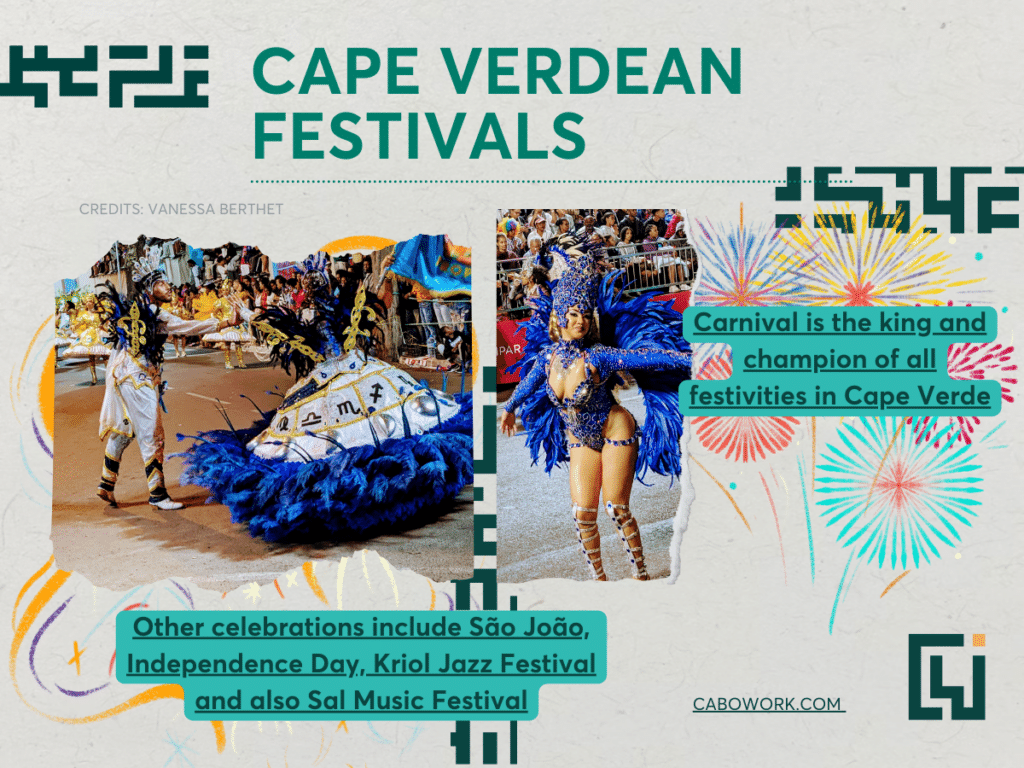
Cape Verde pulsates with festivals year-round!
The undisputed champion is the Carnival in February, exploding with vibrant costumes, music, and dancing, especially in Praia and Mindelo.
Two months later, in June, Fogo Island lights up with the Festival of São João, where you can expect bonfires, energetic dancing, and lively street parties. History enthusiasts won’t miss Independence Day on July 5th. The day is marked by music, parades and fireworks, celebrating the independence from Portugal.
If you’re a fan of the music scene, catch the Kriol Jazz Festival in Praia, in April, or Sal Music Festival in September on Santa Maria Beach. These are celebrations of Cape Verde’s unique musical blend.
So, pack your dancing shoes and festive spirit, because there’s always a party waiting for you in Cape Verde!
Dance in Cape Verdean Culture
Dance is intrinsically linked to music in Cape Verde, with each genre having its own corresponding style. People move to the vibrant rhythms of batuque and the playful steps of coladeira. The lively kola-son-jon danced by firelight during the Saint John festivities adds another dimension to the cultural expression.
While European influences can be seen in waltzes, mazurkas, and contra-danças, Cape Verdean dancers have infused them with their own flair.
Visual Arts
Cape Verde’s artistic expression extends beyond sound and movement.
- Painting is a dynamic art form, with Kiki Lima being a national icon for his expressive works, painting Cabo Verde and its people. Other artists like the painter (and now Minister of Culture and Creative Industries of Cape Verde) Abraão Vicente, and the Figueira Brothers have further enriched the scene.
- Sculpture also finds its place, with artists like the (also) film director Leão Lopes and Lurdes Vieira, ceramic artist, leaving their mark.
- Photography has seen strides as well, with artists like Hélder Paz Monteiro capturing the essence of Cape Verde through their lens.
The richness of Cape Verdean art goes beyond the names mentioned here. Countless artists, past and present, have contributed to this scene. The telling of traditional stories through the “Nho Lobo” tales (folk tales centred on the characters Ti Lobo and Chibinho) and the works left by artists such as Bela Duarte and Manuel Figueira show the depth and diversity of artistic expression.
Art in Cape Verde is not merely entertainment; it’s a way of life. It’s a celebration of heritage, a space for social commentary, and a powerful expression of the soul.
Cape Verde’s artistic traditions continue to evolve, captivating audiences worldwide and ensuring a vibrant future for this cultural treasure trove.
Culture of Cape Verde and the literary landscape
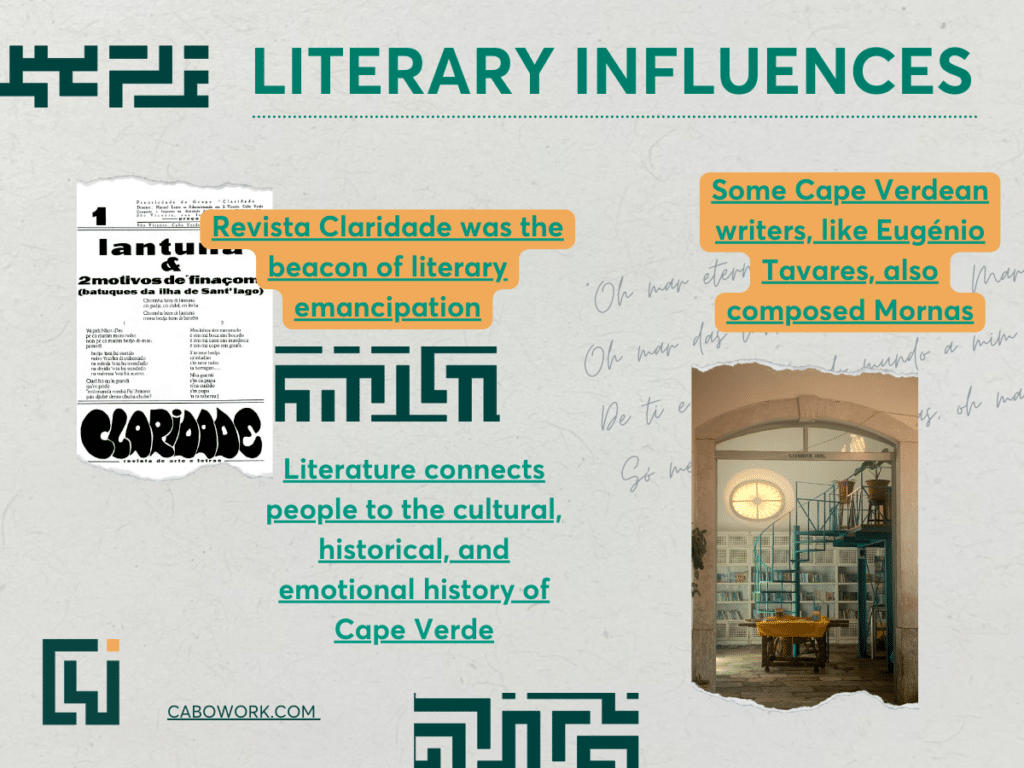
Poetry has played an important role on the national scene, especially during the strict censorship of the Portuguese. At that time in particular, allegorical imagery became a vital tool for conveying genuine emotions.
Notable figures such as Pedro Cardoso and Eugénio Tavares emerged as pioneers, defending national identity and the valorisation of the Creole language.
The Claridade Movement
Founded in 1936, Revista Claridade was a beacon of cultural and political emancipation, breaking the chains with the Portuguese literary traditions. It symbolised a turn towards realism, addressing the social realities of the islands and paving the way for subsequent generations of writers.
The Claridade movement was led by intellectuals such as Jorge Barbosa, Baltasar Lopes da Silva and Manuel Lopes and marked a cultural awakening in the 1940s. The foundations were laid for the literary landscape of the islands.
Through their poems, essays and short stories, the authors captured the essence of Cape Verde, making their literature indispensable for understanding the soul of the country.
The literary African Movement
In the 1950s, the African movement emerged, characterised by a more direct political discourse, exemplified by figures such as Ovídio Martins.
Themes such as migration, nostalgia and identity are dealt with in the books, reflecting the history of the diaspora and their lasting connection to their homeland. Authors such as Germano Almeida offer poignant portraits of Cape Verdean society.
Writers like Amilcar Cabral and Corsino Fortes emerged, breaking away from the conciliatory style of their predecessors. In contemporary times, a new wave of authors continues to enrich the country’s literature, including the journalist and poet Arménio Vieira (Camões Prize), whose work exemplifies a growing pluralism within the literary landscape.
A bridge to the world
Overall, literature in Cape Verde serves as a bridge connecting readers worldwide to the unique cultural, historical, and emotional landscapes of the archipelago. Through the power of storytelling, it invites exploration into the depth of human experiences, fostering a deeper appreciation for Cape Verde’s rich heritage and inspiring curiosity to learn more about this vibrant culture first-hand.
Language, as you can see, has been an important part of Cape Verdean history. Although the official language of Cape Verde is European Portuguese, Cape Verdean Creole (Kriolu) is dominant, spoken by most cape verdeans, if not all. Both languages coexist and are spoken by the people in their daily lives.
Are you visiting Cabo Verde and need a language survival toolkit? Check out our article to help you out with a few phrases of Portuguese and Creole.
Gastronomy

Cape Verdean cuisine is a delightful fusion of flavours, reflecting centuries of cultural exchange. At its core is Cachupa, a hearty stew blending maize, beans, vegetables, and meats or fish—a culinary emblem of the islands.
Catchupa Rica offers a richer variation, while Lagosta Grelhada tantalizes taste buds with grilled lobster in tangy sauce. Seafood shines, with fresh fish, octopus, and shellfish gracing tables. Spices like cinnamon and cloves infuse dishes with depth, while tropical fruits like papaya and mango add sweetness to desserts.
Whether in a lively market or a cosy kitchen, Cape Verdean cuisine celebrates flavour, tradition, and community, inviting all to savour its rich heritage.
Handicrafts in the Culture of Cape Verde
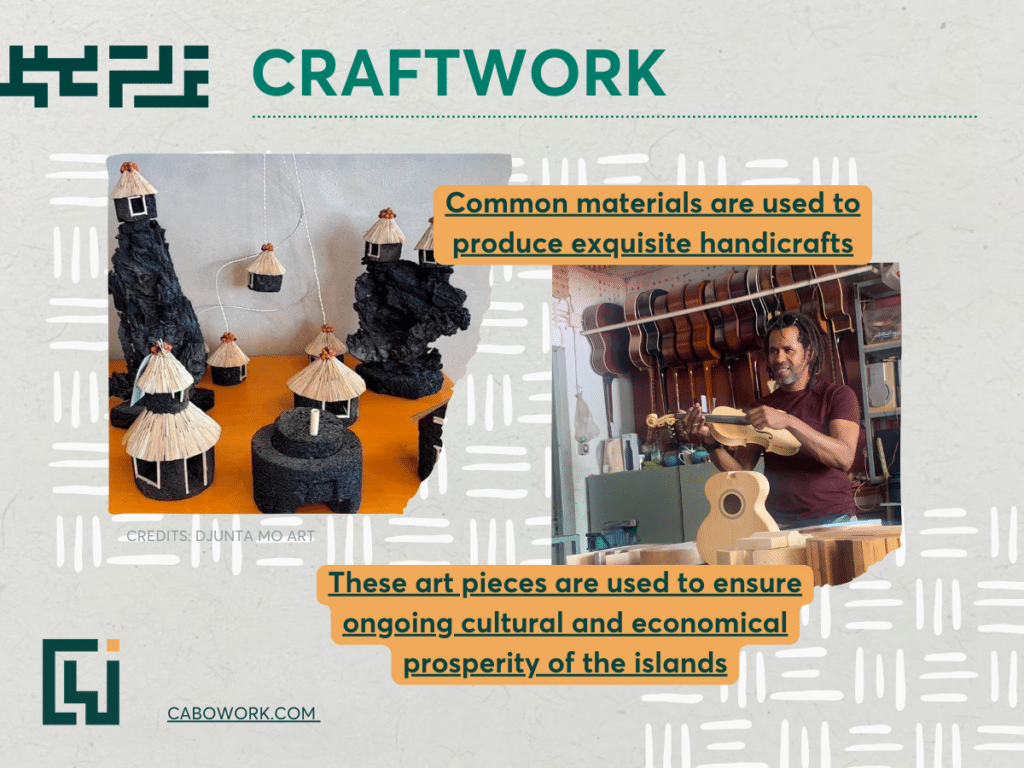
Skilled artisans in Cape Verde create stunning handicrafts out of everyday materials. These treasures are more than souvenirs; they tell the story of the islands’ natural beauty and rich history:
- Weaving is the most common craft in Cape Verde. The Panu di Terra, a textile marvel, is traditionally woven on looms by Cape Verdean artisans.
These textiles showcase their patience and talent, and can be found on clothing, bags, and other artefacts, serving as cherished keepsakes for locals and visitors alike. - Cape Verdean potters also use local clay to create functional and beautiful pieces. Their creations often feature motifs that reflect the island’s landscapes, marine life, and African heritage. Each ceramic piece represents the deep connection between the Cape Verdean people and their environment.
- Woodwork is another traditional art form in Cape Verde. Skilled artisans carve furniture, musical instruments, and decorative items, showcasing the wood’s natural beauty. This tradition is deeply rooted in Cape Verdean culture, with techniques passed down through generations, ensuring its artistic legacy lives on.
These handicrafts are not simply decorations, they are the lifeblood of the Cape Verdean economy. They provide a source of income for families and artisans, while also captivating tourists seeking unique, locally-made treasures.
Furthermore, these crafts serve as guardians of Cape Verdean culture, preserving the stories, traditions, and values of their ancestors so that the islands’ cultural tapestry continues to flourish.
See what more the ten islands of Cape Verde have to offer you in our Cape Verde Activity Guide.


